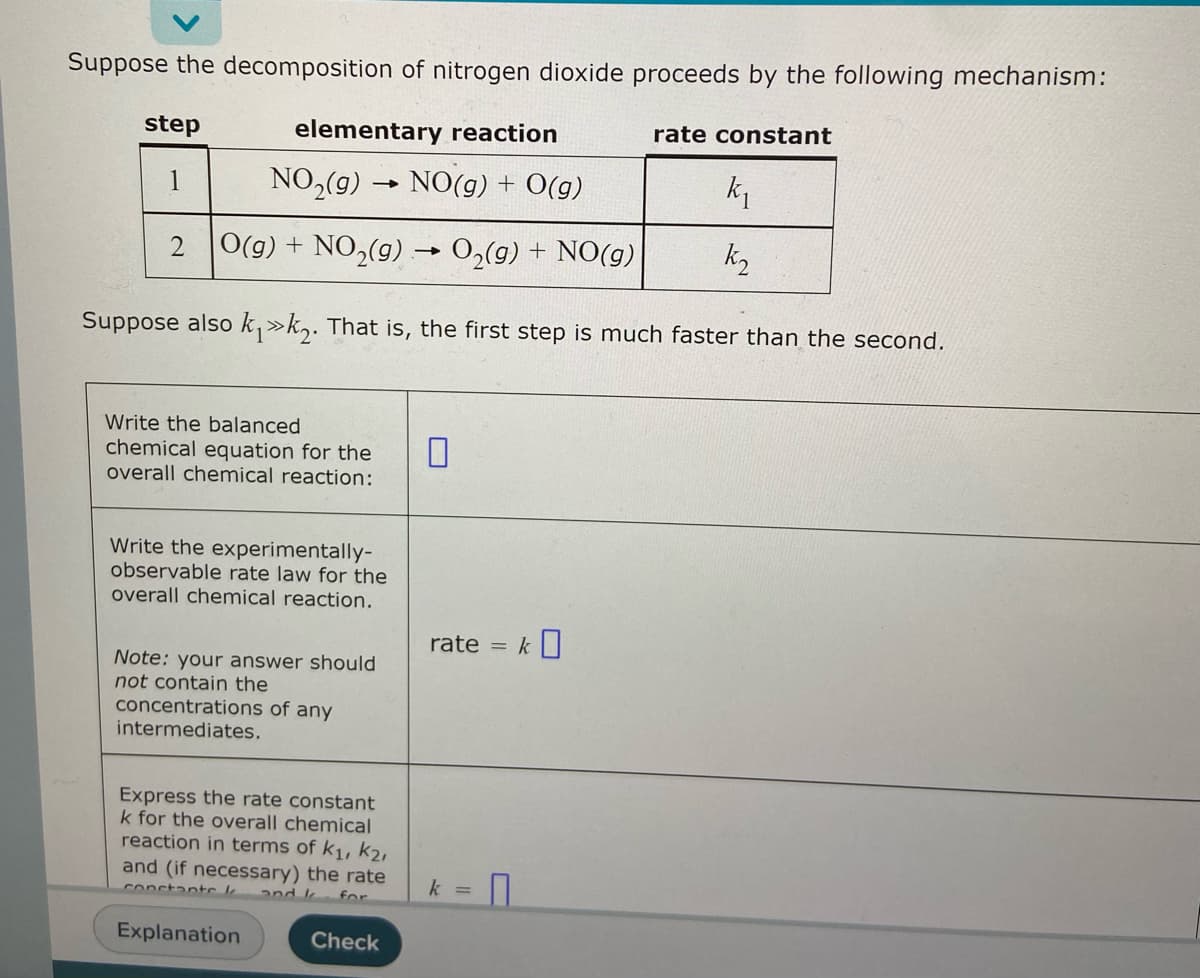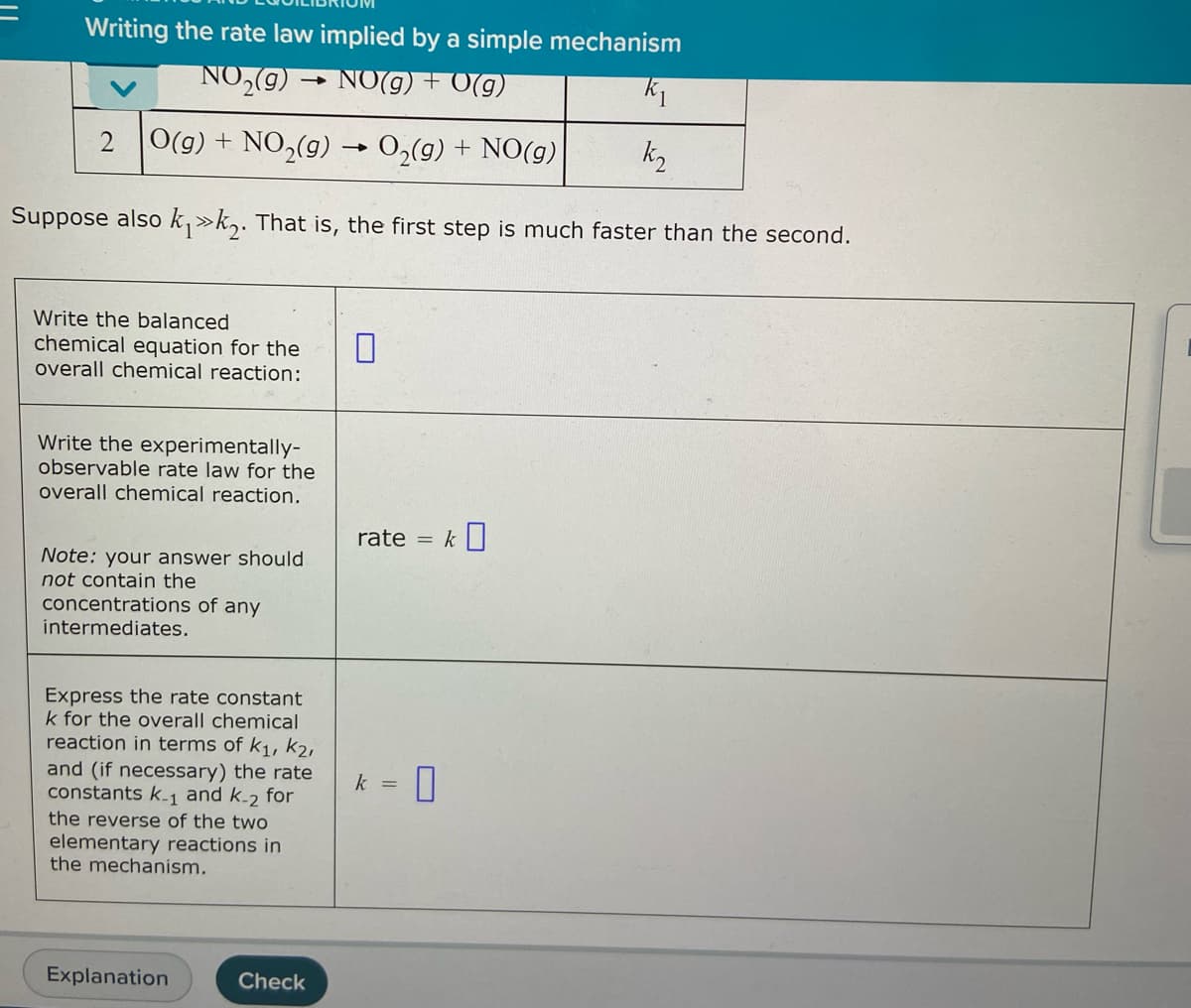Suppose the decomposition of nitrogen dioxide proceeds by the following mechanism: step elementary reaction rate constant 1 NO₂(g) - NO(g) + O(g) k₁ 2 O(g) + NO₂(g) → O₂(g) + NO(g) k₂ Suppose also k₁»k₂. That is, the first step is much faster than the second. Write the balanced 0 chemical equation for the overall chemical reaction: Write the experimentally- observable rate law for the overall chemical reaction. Note: your answer should not contain the concentrations of any intermediates. Express the rate constant k for the overall chemical reaction in terms of K₁, K2, and (if necessary) the rate for Check constants l Explanation rate = k k =
Suppose the decomposition of nitrogen dioxide proceeds by the following mechanism: step elementary reaction rate constant 1 NO₂(g) - NO(g) + O(g) k₁ 2 O(g) + NO₂(g) → O₂(g) + NO(g) k₂ Suppose also k₁»k₂. That is, the first step is much faster than the second. Write the balanced 0 chemical equation for the overall chemical reaction: Write the experimentally- observable rate law for the overall chemical reaction. Note: your answer should not contain the concentrations of any intermediates. Express the rate constant k for the overall chemical reaction in terms of K₁, K2, and (if necessary) the rate for Check constants l Explanation rate = k k =
Chemistry for Engineering Students
4th Edition
ISBN:9781337398909
Author:Lawrence S. Brown, Tom Holme
Publisher:Lawrence S. Brown, Tom Holme
Chapter11: Chemical Kinetics
Section: Chapter Questions
Problem 11.36PAE: The reaction NO(g) + O,(g) — NO,(g) + 0(g) plays a role in the formation of nitrogen dioxide in...
Related questions
Question
Suppose the formation of nitrosyl chloride proceeds by the following mechanism:
step elementary reaction rate constant
(g) (g) (g)
(g) (g) (g)
Suppose also ≫. That is, the first step is much faster than the second.
Write the balanced chemical equation for the overall chemical reaction :
Write the experimentally-observable rate law for the overall chemical reaction.
Note: your answer should not contain the concentrations of any intermediates.
Express the rate constant k for the overall chemical reaction in terms of k1, k2, and (if necessary) the rate constants k-1 and k-2 for the reverse of the two elementary reactions in the mechanism.

Transcribed Image Text:Suppose the decomposition of nitrogen dioxide proceeds by the following mechanism:
step
elementary reaction
rate constant
1
NO₂(g)
→
NO(g) + O(g)
k₁
2 O(g) + NO₂(g) → O₂(g) + NO(g)
k₂
Suppose also k₁»k₂. That is, the first step is much faster than the second.
Write the balanced
0
chemical equation for the
overall chemical reaction:
Write the experimentally-
observable rate law for the
overall chemical reaction.
Note: your answer should
not contain the
concentrations of any
intermediates.
Express the rate constant
k for the overall chemical
reaction in terms of K₁, K2,
and (if necessary) the rate
and I
for
Check
constants l
Explanation
rate = k
k =

Transcribed Image Text:Writing the rate law implied by a simple mechanism
NO₂(g) → NO(g) + V(g)
k₁
2 O(g) + NO₂(g) → O₂(g) + NO(g)
k₂
Suppose also k₁k₂. That is, the first step is much faster than the second.
Write the balanced
chemical equation for the
overall chemical reaction:
0
Write the experimentally-
observable rate law for the
overall chemical reaction.
Note: your answer should
not contain the
concentrations of any
intermediates.
Express the rate constant
k for the overall chemical
reaction in terms of K₁, K2,
and (if necessary) the rate
constants k-1 and k-2 for
the reverse of the two
elementary reactions in
the mechanism.
Explanation
Check
rate =
k =
0
k0
Expert Solution
This question has been solved!
Explore an expertly crafted, step-by-step solution for a thorough understanding of key concepts.
This is a popular solution!
Trending now
This is a popular solution!
Step by step
Solved in 4 steps with 4 images

Knowledge Booster
Learn more about
Need a deep-dive on the concept behind this application? Look no further. Learn more about this topic, chemistry and related others by exploring similar questions and additional content below.Recommended textbooks for you

Chemistry for Engineering Students
Chemistry
ISBN:
9781337398909
Author:
Lawrence S. Brown, Tom Holme
Publisher:
Cengage Learning

Principles of Modern Chemistry
Chemistry
ISBN:
9781305079113
Author:
David W. Oxtoby, H. Pat Gillis, Laurie J. Butler
Publisher:
Cengage Learning

Chemical Principles in the Laboratory
Chemistry
ISBN:
9781305264434
Author:
Emil Slowinski, Wayne C. Wolsey, Robert Rossi
Publisher:
Brooks Cole

Chemistry for Engineering Students
Chemistry
ISBN:
9781337398909
Author:
Lawrence S. Brown, Tom Holme
Publisher:
Cengage Learning

Principles of Modern Chemistry
Chemistry
ISBN:
9781305079113
Author:
David W. Oxtoby, H. Pat Gillis, Laurie J. Butler
Publisher:
Cengage Learning

Chemical Principles in the Laboratory
Chemistry
ISBN:
9781305264434
Author:
Emil Slowinski, Wayne C. Wolsey, Robert Rossi
Publisher:
Brooks Cole


Chemistry
Chemistry
ISBN:
9781305957404
Author:
Steven S. Zumdahl, Susan A. Zumdahl, Donald J. DeCoste
Publisher:
Cengage Learning

Chemistry: An Atoms First Approach
Chemistry
ISBN:
9781305079243
Author:
Steven S. Zumdahl, Susan A. Zumdahl
Publisher:
Cengage Learning